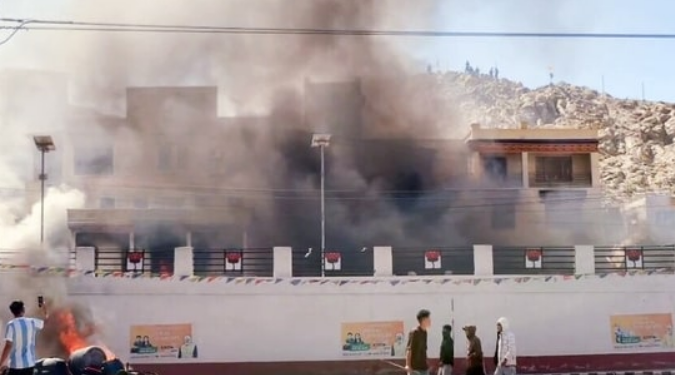
Ladakh has been plunged into turmoil after violent clashes during statehood protests left four people dead and more than 70 injured on Sunday. The unprecedented violence in Leh and Kargil has prompted authorities to impose an indefinite curfew and suspend internet services across the Union Territory.
Longstanding Demand for Statehood
The agitation stems from discontent that has been simmering since August 2019, when Ladakh was carved out of Jammu and Kashmir as a Union Territory without a legislative assembly. Local groups argue that the absence of statehood has deprived residents of political representation and left their land, jobs, and culture vulnerable to outside influence.
Organizations such as the Ladakh Apex Body and Kargil Democratic Alliance have been pressing for two key demands: statehood for Ladakh and inclusion under the Sixth Schedule of the Constitution, which provides safeguards for tribal communities.
The Day of Violence
On Sunday morning, thousands of protestors converged in Leh, carrying placards that read “Statehood Now” and “Protect Ladakh’s Identity.” Initially peaceful, the rally turned tense as demonstrators attempted to march towards government buildings.
Police erected barricades and urged the crowd to disperse, but skirmishes broke out when protestors pushed past security lines. Stones were hurled, prompting security forces to fire tear gas shells and resort to lathi-charges.
Similar unrest was reported in Kargil, where security forces struggled to control crowds. By evening, four people had died from injuries sustained in clashes, while at least 70 others were being treated at hospitals.
Official Reactions
The Union Territory administration has appealed for calm, blaming the violence on “miscreants” who hijacked an otherwise peaceful protest. A curfew was imposed under Section 144, and paramilitary reinforcements were rushed to maintain order.
The Home Ministry is closely monitoring the situation. Sources indicate that senior officials may visit Ladakh soon to assess the ground reality and open talks with protest leaders.
Opposition Criticism
Political parties across India expressed concern over the deaths. Congress leaders accused the Centre of ignoring Ladakh’s demands despite repeated assurances. Leaders of the National Conference and Peoples Democratic Party also called for an impartial inquiry into the police action that led to casualties.
Opposition MPs are expected to raise the issue in Parliament, pressing the government to outline a roadmap for addressing Ladakh’s demands.
Impact on Locals
Residents say the curfew has crippled daily life. Shops, markets, and schools are shut, while mobile networks remain suspended. Families of the injured have voiced anger at the lack of medical preparedness in hospitals, given the scale of the unrest.
Tour operators reported cancellations, with several tourist groups stranded in Leh. The violence has cast a shadow on Ladakh’s image as a peaceful destination, threatening livelihoods dependent on tourism.
Civil Society’s Stand
Leaders of the Ladakh Apex Body and Kargil Democratic Alliance have declared that they will not back down from their demands despite the curfew. They accused the administration of trying to suppress their movement through force rather than dialogue.
Community elders emphasized that Ladakh’s fragile environment and tribal identity require legal safeguards, warning that unrest will continue unless the Centre acknowledges these concerns.
National Security Dimension
Experts point out that Ladakh’s strategic location on the border with China makes stability in the region vital. Any prolonged unrest could complicate security arrangements and divert administrative focus from defense preparedness. The government is therefore under pressure to address the issue swiftly without compromising national interests.
Looking Ahead
With tensions still high, the immediate challenge for authorities is to restore calm while preventing further violence. The High Court is likely to hear petitions from rights groups seeking inquiries into the use of force. The Centre faces the larger task of finding a political solution that balances local aspirations with national priorities.
